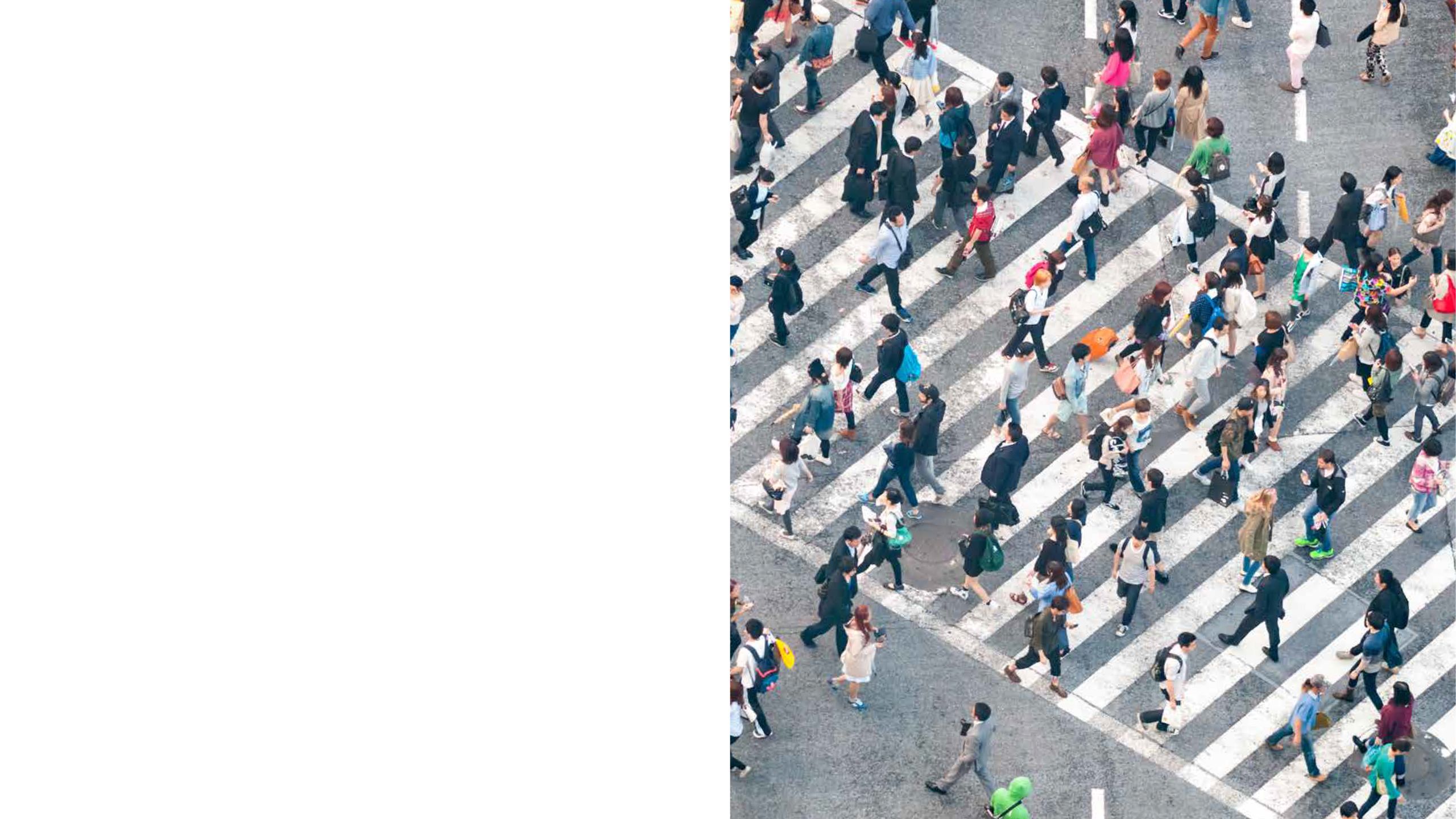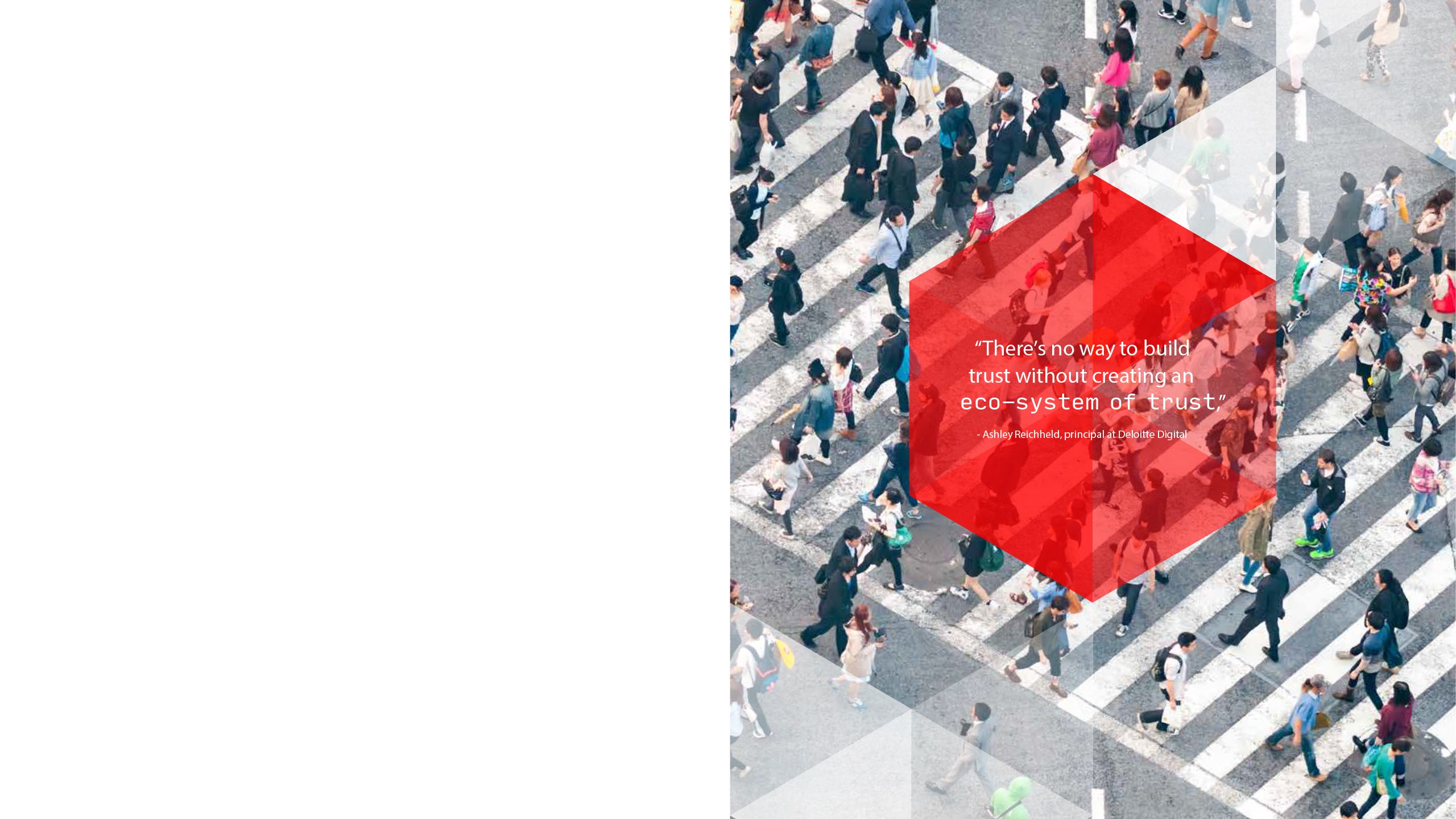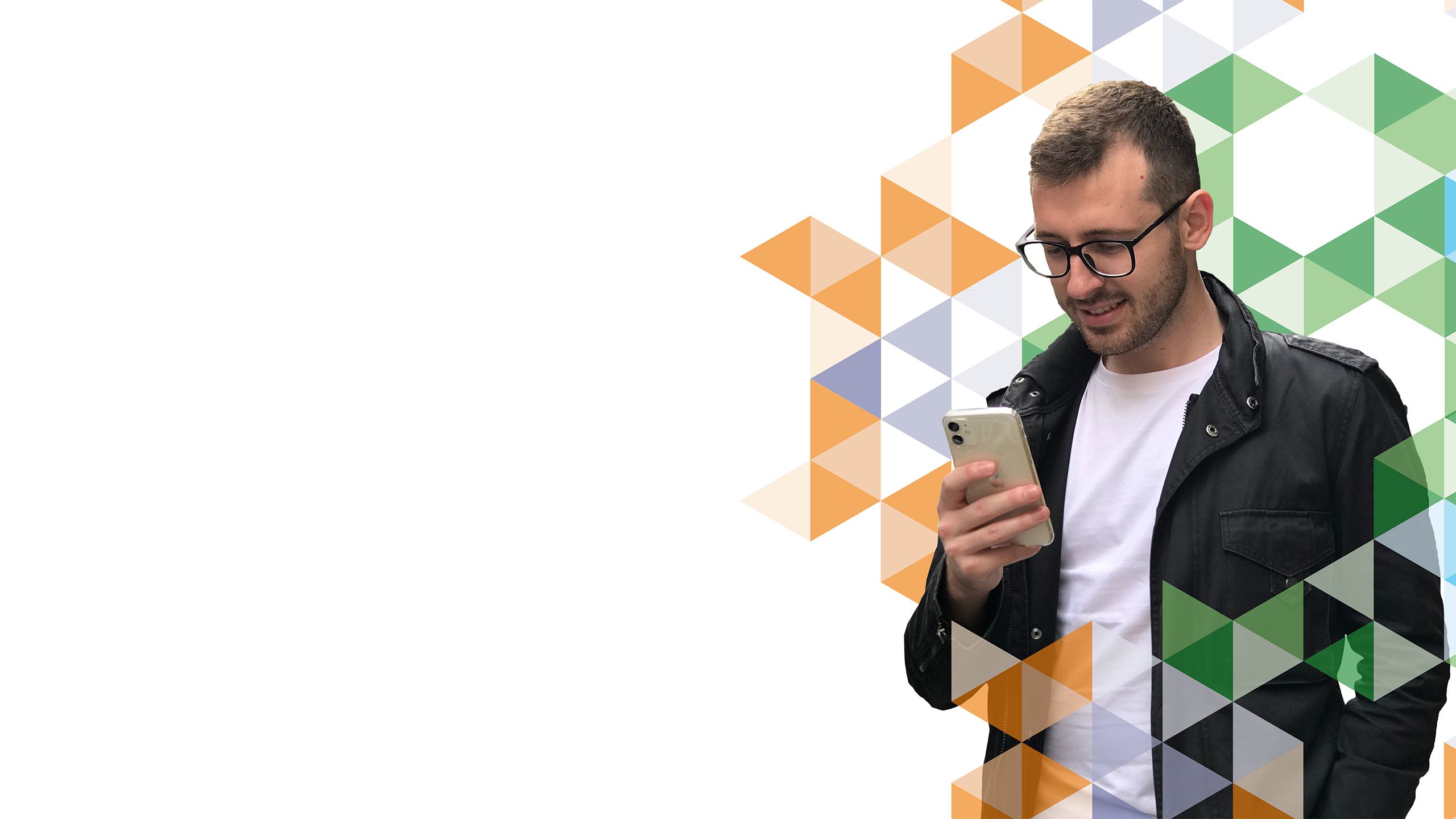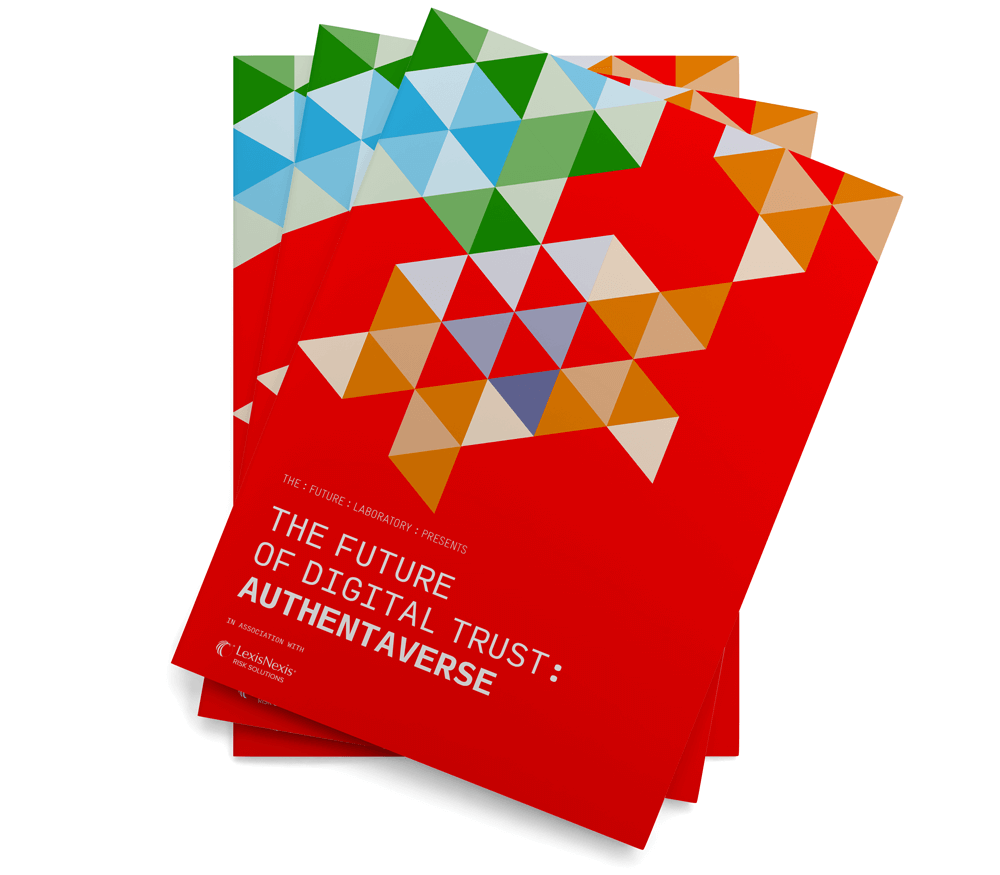THE : FUTURE : LABORATORY : PRESENTS
THE FUTURE
OF DIGITAL TRUST:
AUTHENTAVERSE
IN ASSOCIATION WITH
LEXISNEXIS® RISK SOLUTIONS

Digital trust
and a new era of authentication
By 2026, around a quarter of the world’s population – 2 billion people – are expected to spend at least a part of their day in an online immersive environment or ‘metaverse’.1 These 3D extended reality (XR) platforms promise to blend virtual and real life, creating hybrid spaces that will revolutionise how we live and play.
Combining these worlds with the 2D web environments we are already familiar with, will require a collaborative, safe, reliable and seamless authentication framework that allows users to skip safely, and quickly between virtual worlds. This ‘Authentaverse’ is going to become the bedrock of how, as a society, we successfully embrace this digital evolution.
1 Gartner Predicts 25% of People Will Spend At Least One Hour Per Day in the Metaverse by 2026, Meghan Rimol, 7/2/2022

Digital trust
and a new era of authentication
By 2026, around a quarter of the world’s population – 2 billion people – are expected to spend at least a part of their day in an online immersive environment or ‘metaverse’.1 These 3d extended reality (xr) platforms promise to blend virtual and real life, creating hybrid spaces that will revolutionise how we live and play.
Combining these worlds with the 2d web environments we are already familiar with, will require a collaborative, safe, reliable and seamless authentication framework that allows users to skip safely, and quickly between virtual worlds. This ‘authentaverse’ is going to become the bedrock of how, as a society, we successfully embrace this digital evolution.
1 Gartner Predicts 25% of People Will Spend At Least One Hour Per Day in the Metaverse
by 2026, Meghan Rimol, 7/2/2022

PART ONE
Digital Trust:
Why now?
A call to action on the increasing importance of digital trust to society and business.

Trust – and increasingly digital trust – is fast becoming the most valuable cultural currency of our time. With digital experiences now central to almost every interaction, transaction and relationship between businesses and consumers – the methods needed to establish trust, and the way that trust is enshrined, are transforming.
As citizens’ daily lives become enmeshed in their digital worlds, trust in digital platforms, services and products is becoming non-negotiable.
An organisation’s ability to protect its customers’ information, assets and confidentiality reflects not only a robust governance risk and compliance framework, but its core values – with the ability to trust in a business’s capabilities and motives scoring highly on consumers’ agendas.
Almost half (47%) of people in the UK would withdraw trust from a business because of data mishandling or mis-selling, according to Okta

Trust – and increasingly digital trust – is fast becoming the most valuable cultural currency of our time. With digital experiences now central to almost every interaction, transaction and relationship between businesses and consumers – the methods needed to establish trust, and the way that trust is enshrined, are transforming.
As citizens’ daily lives become enmeshed in their digital worlds, trust in digital platforms, services and products is becoming non-negotiable.
An organisation’s ability to protect its customers’ information, assets and confidentiality reflects not only a robust governance risk and compliance framework, but its core values – with the ability to trust in a business’s capabilities and motives scoring highly on consumers’ agendas.
Almost half (47%) of people in the UK would withdraw trust from a business because of data mishandling or selling, according to Okta

PART TWO
The Circle of Trust:
What to know?
Digital trust’s future outlook – why a change of approach is needed across businesses.

The vast rate of technological acceleration is fuelling a reset for society, as industries, digital lives, platforms and interactions become increasingly interlinked, redefining how individuals engage with the world.
But, the transformative potential of these game-changing technologies is undermined by a fundamental lack of understanding, collaboration, and ultimately, trust between users, governments, businesses and institutions.
In an increasingly fractious society, trust is a precious commodity. The giving and receiving of trust has grown inward-looking and defensive, made worse by those organisations that covertly or wholly unethically mishandle data.
The future for building digital trust must reflect a symbiotic and responsive eco-system, where organisations, companies, institutions, governments, and individuals collaborate to create ‘a circle of trust’.
To achieve this will require invisible and inter-linked layers of seamless and secure authentication processes that enables users to skip between spaces and services without friction, assured that their personal information is protected and those with whom they engage, are verified.
An Authentaverse – if you will, is a vision of how this eco-system can exist, enabling the full potential of seamless, accessible transformation to be realised.


PART THREE
The Digital Trust Landscape: What’s happening?
The sociocultural and industry happenings of today that will affect the future requirements for digital trust tomorrow.

Trust Exodus – a crisis of trust is unravelling across society. Citizens are rethinking allegiances to traditional trust bases, although pockets of hope remain. Trust voids formed by prolonged economic anxiety, disinformation, and failures of leadership hamper progress
A future Authentaverse of ubiquitous digital trust between entities is far from assured. Digital trust is beset by many challenges and is eroded every day by myriad environmental factors.
Trust Exodus
Patterns are shifting. Traditional seats of assured trust, such as government, no longer command such authority. This creates opportunities for ethical business to fill the void, provided legislative and governance hurdles can be overcome.
The Techlash
Technology is still the most trusted business sector overall, but the often questionable morals displayed by Big Tech cause many citizens to rethink their allegiances. Future legislation must work with, not against the tech sector.
The Digital Divide
Digital exclusion is a growing societal and economic threat. Future frameworks require a holistic and contextualised approach to inclusivity, ensuring no one is locked out of the digital economy.
Data Demystified
Despite society’s obsession with digital services, public understanding of privacy and how data is used, remains poor. Transparency and awareness of the mutual benefits of ethical data sharing are key to removing public fear.
Governance3
Web3 promises a decentralised digital future in which people are the architects and owners of community-minded digital spaces. Existing web governance frameworks are inadequate and must transform accordingly.
Fraud Rising
The digital economy multiplies opportunities and in-routes for fraudsters. The response must be cross-industry standardisation, and cooperation over competition, treating fraud as a shared problem.

A future Authentaverse of ubiquitous digital trust between entities is far from assured. Digital trust is beset by many challenges and is eroded every day by myriad environmental factors.
Trust Exodus
Patterns are shifting. Traditional seats of assured trust, such as government, no longer command such authority. This creates opportunities for ethical business to fill the void, provided legislative and governance hurdles can be overcome.
The Techlash
Technology is still the most trusted business sector overall, but the often questionable morals displayed by Big Tech cause many citizens to rethink their allegiances. Future legislation must work with, not against the tech sector.
The Digital Divide
Digital exclusion is a growing societal and economic threat. Future frameworks require a holistic and contextualised approach to inclusivity, ensuring no one is locked out of the digital economy.
Data Demystified
Despite society’s obsession with digital services, public understanding of privacy and how data is used, remains poor. Transparency and awareness of the mutual benefits of ethical data sharing are key to removing public fear.
Governance3
Web3 promises a decentralised digital future in which people are the architects and owners of community-minded digital spaces. Existing web governance frameworks are inadequate and must transform accordingly.
Fraud Rising
The digital economy multiplies opportunities and in-routes for fraudsters. The response must be cross-industry standardisation, and cooperation over competition, treating fraud as a shared problem.

PART FOUR
The Pillars
of Digital Trust:
How to win?
Four ‘citizen-first’ principles sit at the heart of a flourishing future for digital trust, acting as a framework for the next era of digital transformation and laying the groundwork for how an Authentaverse is built and brokered.


EMPOWERMENT
Users must be empowered to engage with digital culture, building confidence and literacy in their interactions and transactions through awareness, education and expertise, to ensure the societal and economic risks and depletion of trust caused by digital exclusion and data mystification are avoided.
|
REFLECT: |
DEFINE: |
ADAPT: |
|---|---|---|
|
What should we be asking? |
Where should we aim to be? |
How do we get there? |

PROTECTION
Users must be protected across evolving contexts and variables, using technological solutions that adapt in real-time to complex, changing nuance. These solutions will offer a personalised approach to protection that remains in step with modern user expectations for intuitive, intelligent digital interactions.
|
REFLECT: |
DEFINE: |
ADAPT: |
|---|---|---|
|
What should we be asking? |
Where should we aim to be? |
How do we get there? |

UNDERSTANDING
Users must be better understood as the person behind the data point, with feedback-loops enabling deeper understanding of personal characteristics and identifiers to enhance decision-making and intelligence. Here, behaviour and identity are entwined in a trust ecosystem that offers secure experiences that are both fit for people and purpose.
|
REFLECT: |
DEFINE: |
ADAPT: |
|---|---|---|
|
What should we be asking? |
Where should we aim to be? |
How do we get there? |

RESPECT
Businesses must transfer agency into the hands of users, setting up a more equal value exchange for their data that offers opportunities for genuine trust building within mutually beneficial long-term relationships by allowing users to influence and control outcomes on their terms.
|
REFLECT: |
DEFINE: |
ADAPT: |
|---|---|---|
|
What should we be asking? |
Where should we aim to be? |
How do we get there? |

EMPOWERMENT
Users must be empowered to engage with digital culture, building confidence and literacy in their interactions and transactions through awareness, education and expertise, to ensure the societal and economic risks and depletion of trust caused by digital exclusion and data mystification are avoided.
REFLECT:
What should we be asking?
How does our online experience meet the needs of a diverse spectrum of users with varying levels of digital access and education? How can we empower all users to feel equally confident in interacting with us?
DEFINE:
Where should we aim to be?
Educate users about how their data is used, who it is shared with and why and how this benefits them, allowing us to gain their trust and confidence in engaging with us.
ADAPT:
How do we get there?
Use expertise to provide much-needed education and literacy alongside transparent and open solutions and experiences that are designed to inform and protect users regardless of their digital literacy.

PROTECTION
Users must be protected across evolving contexts and variables, using technological solutions that adapt in real-time to complex, changing nuance. These solutions will offer a personalised approach to protection that remains in step with modern user expectations for intuitive, intelligent digital interactions.
REFLECT:
What should we be asking?
How does our business make use of diverse and crowdsourced data sources to offer protection for users that goes beyond one-size-fits-all?
DEFINE:
Where should we aim to be?
Users protected across multiple contexts, with triangulated data sources confirming who they are with little friction across different platforms and situations, enabling enhanced value through the convenience of a seamless service.
ADAPT:
How do we get there?
Harness behavioural biometrics and layered data sources to build a nuanced profile of your users, centring authentication around security metrics that cannot be copied or impersonated.

UNDERSTANDING
Users must be better understood as the person behind the data point, with feedback-loops enabling deeper understanding of personal characteristics and identifiers to enhance decision-making and intelligence. Here, behaviour and identity are entwined in a trust ecosystem that offers secure experiences that are both fit for people and purpose.
REFLECT:
What should we be asking?
How do we use digital signals and patterns to better understand our end-users and their behaviour and make their experience more secure and seamless?
DEFINE:
Where should we aim to be?
Our users engage in a mutually trusting information exchange with us, enabling a deep understanding of who they are through their digital behaviour and identifying factors, allowing us to offer protection that is tailored to fit the individual.
ADAPT:
How do we get there?
Invest in solutions that enrich the understanding of individual customers’ human-digital identity and behaviours, creating a feedback eco-system that is constantly learning and contextualising to course-correct and enhance the experience for them.

RESPECT
Businesses must transfer agency into the hands of users, setting up a more equal value exchange for their data that offers opportunities for genuine trust building within mutually beneficial long-term relationships by allowing users to influence and control outcomes on their terms.
REFLECT:
What should we be asking?
How, if at all, does our business approach the value exchange in return for our customers’ data?
DEFINE:
Where should we aim to be?
Our users have agency and influence over their data, engaging in a fair value exchange through an open data model designed for both ease and enhanced protection, creating trust across the value chain and encouraging them to partner with us for the long term.
ADAPT:
How do we get there?
Ensure that the critical structural features are in place to enable data and intelligence sharing and analysis and to demonstrate a more valuable return for users, when sharing their data.
PART FIVE
Welcome to The Authentaverse:
What next?
Embrace these Pillars of Digital Trust and the result will be radical transformation and a flourishing Authentaverse. Users will benefit from greater choice, control and agency, and organisations will be freed to deliver new innovative services and immersive engagement.

This section explores the key trends that The Authentaverse will set in motion over the next decade and beyond.
Autonomous Access
Welcome to an era of autonomous access, with citizens able to seamlessly switch between hyper-personalised digital services from myriad providers in an open ecosystem built on freedom and choice. Interoperability and open access will see competition replaced with collaboration, while the ability to truly ‘know’ every user will enable meaningful and valuable personalisation of services.
Immersive Institutions
By 2030, all-new levels of access and immersion in virtual services will be a reality. Multiple metaverses promise a paradigm change for human interactions with business – The Authentaverse will mitigate the immersive risks and challenges such worlds pose, allowing users to move through them seamlessly and with ease. Authentication itself will become increasingly immersive and real-time.
Alternet Economics
The Authentaverse will embrace transparency and empower citizens to harness their data for good. Emerging platforms will seek to redistribute wealth in the data commerce market, with user-centric and community models empowering individuals to monetise aspects of their personal information and give them the knowledge and oversight to set their own data terms. The societal upshot will be greater volumes of highly accurate and accessible personal data, even spawning whole new business models, in its wake.
AI Advocates
Consumers will increasingly defer decision-making to AI assistants who will advocate on their behalf. Beyond assisting users, advanced AI and machine learning technologies will also assist organisations in their data usage – streamlining consent management and ensuring compliance with current and future regulations. Businesses will need to develop strategies to work with these AI assistants and personal technology, or risk being excluded from their users’ digital lives.
Interfaceless Futures
With security at the forefront of consumers’ minds, biometric technology will underpin The Authentaverse – bypassing the need for constant authentication through a deep understanding of users’ unique characteristics and their digital footprints. Far-reaching data education will serve to remove biometrics’ dystopian characterisation, moving towards a narrative of invisible, seamless, protected and convenient experiences.
Smart Friction
Seamless experiences unlocked by The Authentaverse will prove transformative, with embedded friction and behind-the-scenes verification creating a future digital architecture that is as secure as it is streamlined. In future, the façade of protection will fade away, with obtrusive authentication checks a thing of the past, replaced by technology that knows users intimately, without being intrusive.
Educational Ecosystems
Today’s industry-wide knowledge gap will be replaced by digital citizens confident and empowered to engage, without prejudice. The next decade will see businesses tasked with educating and upskilling key players across the value chain, to set an Authentaverse in motion. Collaboration between industry, trade bodies and government will drive a more relevant curriculum that will see future generations supported to meaningfully engage with our future digital ecosystem.

PART SIX
Conclusion
By 2030, the digital landscape will be transformed, as next-generation data technologies usher in a passwordless future afforded by new approaches to digital trust.

Download a complimentary copy of the full report THE FUTURE OF DIGITAL TRUST: AUTHENTAVERSE, a collaboration between The Future Laboratory and LexisNexis® Risk Solutions, to lay out the framework for how businesses must embark on this future, posing four pillars of digital trust.

